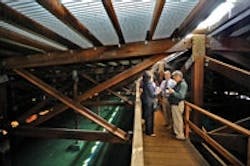About the author:
Leslie Streicher is associate editor for Water & Wastes Digest. Streicher can be reached at [email protected] or 847.954.7922.
Rockets in the early part of the 20th century were found only in science fiction. It was not until the onset of World War II that a few pioneering scientists discovered they could make this fiction a reality.
In 1936, the Jet Propulsion Laboratory (JPL) in Pasadena, Calif., was home to the “rocket boys,” one such group of scientists who dreamed of creating a machine to take mankind where it never had gone before. The laboratory, owned by Cal Tech, contributed vastly to our nation’s advancement of aeronautical engineering. By 1958, JPL had joined NASA under a new funding agreement and completed the launch of a four-stage rocket named the Explorer 1, beginning the “space race” with the Soviet Union.
A History of Contamination
Although the space community was seeing significant progress, Pasadena’s water quality was all but progressing. Workers at JPL were disposing of sanitary wastes and laboratory chemicals in unlined subsurface seepage pits—a common and acceptable practice at the time.
“Some of the pits received volatile organic compounds (VOCs) and other waste materials, which made their way in the deep groundwater,” said Steve Slaten, remedial project manager of NASA’s Comprehensive Environmental Restoration and Compensation Liability Act (CERCLA) Groundwater Cleanup Program at JPL.
It had an insidious effect. By the late 1950s, after the dangers were realized, this disposal method was discontinued and a new sanitary sewer system was installed at JPL to handle wastewater. But the damage was already done.
Nearly 20 years later, VOCs were discovered in the groundwater; within a decade, a temporary VOC treatment plant was installed. Air-stripping technology with granular activated carbon for off-gassing was used to combat the unwanted chemicals. By 1997, however, it seemed to be a losing battle.
Perchlorate was discovered in one of four Pasadena Water & Power (PWP)-owned wells, exceeding the State of California Department of Public Health’s notification level of 18 µg per liter. At the turn of the century, all four wells—Arroyo, Well 52, Ventura and Windsor—were closed for exceeding state-regulated perchlorate levels. For nearly a decade, the city was left to purchase drinking water from the Metropolitan Water District (MWD) of Southern California, and costs were piling up.
Eager to reinvigorate the local water supply, city and PWP officials engaged NASA’s CERCLA program in 2006 to fund the construction of a new treatment plant and groundwater cleanup. One year later, rehabilitation plans were finalized.
Anatomy of a Treatment System
According to the U.S. Environmental Protection Agency, air stripping and liquid phase granular activated carbon (LGAC) are the best technologies for VOC removal. Considering the concentration of VOCs in Pasadena’s groundwater, LGAC was determined to be more cost-effective than air stripping. After conducting research trials, NASA identified two treatment processes that were ideal for the cause: fluidized bed reactors and ion exchange.
“Ion exchange is the only technology successfully implemented to remove perchlorate from drinking water in California,” Slaten said.
In the end, ion exchange was chosen. The method uses small plastic beads, or resin, to remove perchlorate from water as it passes through a tank. Perchlorate particles attach to the resin, which then is removed and sent to a licensed disposal facility.
“This method was the most commercially viable and proven technology for removal of perchlorate in drinking water,” said PWP General Manager Phyllis Currie.
Rebirth of a Community Water Supply
In July 2011, PWP began operating the new 10-million-gal-per-day Monk Hill Water Treatment Plant using ion-exchange technology to remove VOCs and perchlorate from the four local wells. The fixed-bed treatment plant comprises 18 steel vessels, designed by Calgon Carbon Corp., and sits next to the city-owned Windsor Reservoir.
“The Windsor Reservoir was the most logical location since the four wells ultimately pump in the reservoir,” Currie said.
Upgrades to the 4.8-million-gal covered reservoir included a 2,772-module solar array on the roof, which saves the city $20,000 a year in
operating costs.
The four wells reopened after undergoing extensive rehabilitation. New pipes, electrical components and pumps help manage high-efficiency booster pumps, which push extracted groundwater through the entire system to the reservoir.
A new water disinfection building using chloramine was constructed to match the disinfectant in the city’s imported water from MWD. Monk Hill basin’s aquifer, which runs below Hahamongna Watershed Park in the Arroyo Seco, also was restored, allowing treated water from the new plant to be distributed to the Arroyo spreading basins.
“The water from the new treatment plant reduces the city’s reliance on imported water,” Currie said. “Producing the water locally, instead of hundreds of miles away, is a benefit to the entire region.”
All images courtesy of Pasadena Water & Power
Download: Here
